
(a)
Interpretation:
The electronic configuration of tungsten should be determined.
Concept Introduction:
The electrons are arranged around the nucleus of an atom in an increasing order of energy levels and this description of orbitals of atom occupied by electrons is known as electronic configuration.
Answer to Problem 2.10P
Electronic configuration of tungsten is:
Explanation of Solution
Electrons are distributed in the orbitals of the sub-shell. The specific region of space in which the movements of electrons are confined is said to be shells which are divided into sub-shells and are s-, p-, d-, and f-. Among these sub-shells, the electrons are grouped as orbitals.
The numbers of electrons that these sub-shells can hold are:
s-block - 2
p-block - 6
d-block - 10
f-block - 14
The increasing order of energy of shells, sub-shell is:
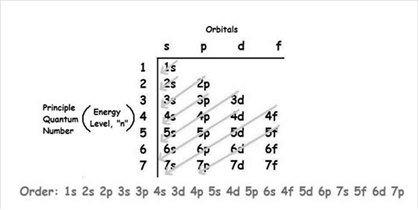
As the number of electrons for a neutral atom is equal to the atomic number of an atom so,
The atomic number of tungsten is = 74
The electronic configuration of tungsten is:
(b)
Interpretation:
The electronic configuration of cobalt should be determined.
Concept Introduction:
The electrons are arranged around the nucleus of an atom in an increasing order of energy levels and this description of orbitals of atom occupied by electrons is known as electronic configuration.
Answer to Problem 2.10P
Electronic configuration of cobalt is:
Explanation of Solution
Electrons are distributed in the orbitals of the sub-shell. The specific region of space in which the movements of electrons are confined is said to be shells which are divided into sub-shells and are s-, p-, d-, and f-. Among these sub-shells, the electrons are grouped as orbitals.
The numbers of electrons that these sub-shells can hold are:
s-block - 2
p-block - 6
d-block - 10
f-block - 14
The increasing order of energy of shells, sub-shell is:
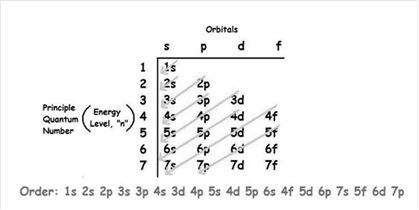
As the number of electrons for a neutral atom is equal to the atomic number of an atom so,
The atomic number of cobalt is = 27
The electronic configuration of cobalt is:
(c)
Interpretation:
The electronic configuration of zirconium should be determined.
Concept Introduction:
The electrons are arranged around the nucleus of an atom in an increasing order of energy levels and this description of orbitals of atom occupied by electrons is known as electronic configuration.
Answer to Problem 2.10P
The electronic configuration of zirconium is:
Explanation of Solution
Electrons are distributed in the orbitals of the sub-shell. The specific region of space in which the movements of electrons are confined is said to be shells which are divided into sub-shells and are s-, p-, d-, and f-. Among these sub-shells, the electrons are grouped as orbitals.
The numbers of electrons that these sub-shells can hold are:
s-block - 2
p-block - 6
d-block - 10
f-block - 14
The increasing order of energy of shells, sub-shell is:
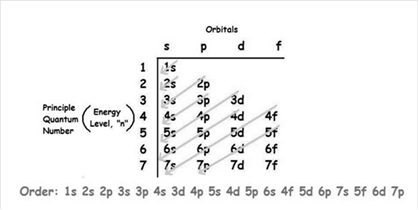
As the number of electrons for a neutral atom is equal to the atomic number of an atom so,
The atomic number of zirconium is = 40
The electronic configuration of zirconium is;
(d)
Interpretation:
The electronic configuration of uranium should be determined.
Concept Introduction:
The electrons are arranged around the nucleus of an atom in an increasing order of energy levels and this description of orbitals of atom occupied by electrons is known as electronic configuration.
Answer to Problem 2.10P
Electronic configuration of uranium is:
Explanation of Solution
Electrons are distributed in the orbitals of the sub-shell. The specific region of space in which the movements of electrons are confined is said to be shells which are divided into sub-shells and are s-, p-, d-, and f-. Among these sub-shells, the electrons are grouped as orbitals.
The numbers of electrons that these sub-shells can hold are:
s-block - 2
p-block - 6
d-block - 10
f-block - 14
The increasing order of energy of shells, sub-shell is:
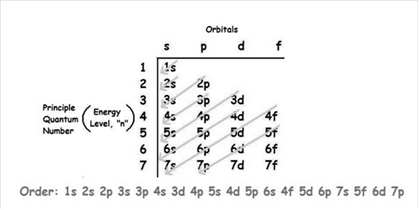
As the number of electrons for a neutral atom is equal to the atomic number of an atom so,
The electronic configuration of uranium is:
(e)
The electronic configuration of aluminum should be determined.
Concept Introduction:
The electrons are arranged around the nucleus of an atom in an increasing order of energy levels and this description of orbitals of atom occupied by electrons is known as electronic configuration.
Answer to Problem 2.10P
Electronic configuration of aluminum is:
Explanation of Solution
Electrons are distributed in the orbitals of the sub-shell. The specific region of space in which the movements of electrons are confined is said to be shells which are divided into sub-shells and are s-, p-, d-, and f-. Among these sub-shells, the electrons are grouped as orbitals.
The numbers of electrons that these sub-shells can hold are:
s-block - 2
p-block - 6
d-block - 10
f-block - 14
The increasing order of energy of shells, sub-shell is:
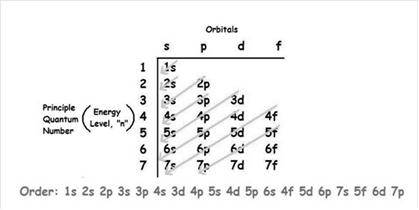
As the number of electrons for a neutral atom is equal to the atomic number of an atom so,
The atomic number of aluminum is = 13
The electronic configuration of aluminum is:
Want to see more full solutions like this?
Chapter 2 Solutions
Essentials Of Materials Science And Engineering
- I need help on this question. step by step calculations and answers.arrow_forwardDon't use ai to answer I will report you answerarrow_forwardjan G(f) f Sketch the spectrum of g(t), which has a maximum frequency of 5 kHz, if it is sampled at the following sampling frequencies: 7 kHz, 10 kHz and 15 kHz. Indicate if and how the signal can be recovered at each sampling frequency.arrow_forward
- Don't use ai to answer i will report your answerarrow_forwardA single tone is modulated using FM transmitter. The SNR, at the input of the demodulator 20 dB. If the maximum frequency of the modulating signal is 4 kHz, and the maximum equency deviation is 12 kHz, find the SNR, and the bandwidth (using Carson rule) at the ollowing conditions: . For the given values of fm and Af. !. If the amplitude of the modulating signal is increased by 80%. 3. If the amplitude of the modulating signal is decreased by 50%, and frequency of modulating signal is increased by 50%.arrow_forwardThe circuit shown below on the left has the following parameters: V₁ = 5 V. R₁ = 40, R₂ = 40, α = 0.1. This circuit can be replaced by an equivalent circuit shown below on the right such that the voltage and current received by an arbitrary load resistor RL, are identical when connected to either circuits. Determine the value of the resistor R (in ) in the equivalent circuit. R₁ Rx R2 R₁ Vx R₁ Vi απ. barrow_forward
- Lab 07: Java Graphics (Bonus lab) In this lab, we'll be practicing what we learned about GUIs, and Mouse events. You will need to implement the following: ➤ A GUI with a drawing panel. We can click in this panel, and you will capture those clicks as a Point (see java.awt.Point) in a PointCollection class (you need to build this). о The points need to be represented by circles. Below the drawing panel, you will need 5 buttons: о An input button to register your mouse to the drawing panel. ○ о о A show button to paint the points in your collection on the drawing panel. A button to shift all the points to the left by 50 pixels. The x position of the points is not allowed to go below zero. Another button to shift all the points to the right 50 pixels. The x position of the points cannot go further than the You can implement this GUI in any way you choose. I suggest using the BorderLayout for a panel containing the buttons, and a GridLayout to hold the drawing panel and button panels.…arrow_forwardK/S 46. (O المهمات الجديدة 0 المنتهية 12 المغـ ۱۱:۰۹ search ليس لديك اي مهمات ☐ ○ ☑arrow_forwardthe answer should be: V2= -(P0-PL/2μL)(dx-x^)+Ux/darrow_forward
- For some viscoelastic polymers that are subjected to stress relaxation tests, the stress decays with time according to a(t) = a(0) exp(-4) (15.10) where σ(t) and o(0) represent the time-dependent and initial (i.e., time = 0) stresses, respectively, and t and T denote elapsed time and the relaxation time, respectively; T is a time-independent constant characteristic of the material. A specimen of a viscoelastic polymer whose stress relaxation obeys Equation 15.10 was suddenly pulled in tension to a measured strain of 0.5; the stress necessary to maintain this constant strain was measured as a function of time. Determine E (10) for this material if the initial stress level was 3.5 MPa (500 psi), which dropped to 0.5 MPa (70 psi) after 30 s.arrow_forward1. Consider the following a unity feedback control system. R(s) + E(s) 500(s+2)(s+5)(s+6) s(s+8)(s+10)(s+12) -Y(s) Find the followings: a) Type of the system b) Static position error constant Kp, Static velocity error constant Ry and Static acceleration error constant Ka c) Find the steady-state error of the system for (i) step input 1(t), (ii) ramp input t 1(t), (iii) parabolic input t² 1(t). 2. Repeat the above problem for the following system. R(s) + E(s) 500(s + 2)(s + 5) (s+8)(s+ 10)(s+12) Y(s) 3. Repeat the above problem for the following system. R(s) + E(s) 500(s+2)(s+4)(s+5)(s+6)(s+7) s²(s+8)(s+10)(s+12) Y(s)arrow_forwardFor the flows in Examples 11.1 and 11.2, calculate the magnitudes of the Δ V2 / 2 terms omitted in B.E., and compare these with the magnitude of the ℱ terms.arrow_forward
 MATLAB: An Introduction with ApplicationsEngineeringISBN:9781119256830Author:Amos GilatPublisher:John Wiley & Sons Inc
MATLAB: An Introduction with ApplicationsEngineeringISBN:9781119256830Author:Amos GilatPublisher:John Wiley & Sons Inc Essentials Of Materials Science And EngineeringEngineeringISBN:9781337385497Author:WRIGHT, Wendelin J.Publisher:Cengage,
Essentials Of Materials Science And EngineeringEngineeringISBN:9781337385497Author:WRIGHT, Wendelin J.Publisher:Cengage, Industrial Motor ControlEngineeringISBN:9781133691808Author:Stephen HermanPublisher:Cengage Learning
Industrial Motor ControlEngineeringISBN:9781133691808Author:Stephen HermanPublisher:Cengage Learning Basics Of Engineering EconomyEngineeringISBN:9780073376356Author:Leland Blank, Anthony TarquinPublisher:MCGRAW-HILL HIGHER EDUCATION
Basics Of Engineering EconomyEngineeringISBN:9780073376356Author:Leland Blank, Anthony TarquinPublisher:MCGRAW-HILL HIGHER EDUCATION Structural Steel Design (6th Edition)EngineeringISBN:9780134589657Author:Jack C. McCormac, Stephen F. CsernakPublisher:PEARSON
Structural Steel Design (6th Edition)EngineeringISBN:9780134589657Author:Jack C. McCormac, Stephen F. CsernakPublisher:PEARSON Fundamentals of Materials Science and Engineering...EngineeringISBN:9781119175483Author:William D. Callister Jr., David G. RethwischPublisher:WILEY
Fundamentals of Materials Science and Engineering...EngineeringISBN:9781119175483Author:William D. Callister Jr., David G. RethwischPublisher:WILEY





